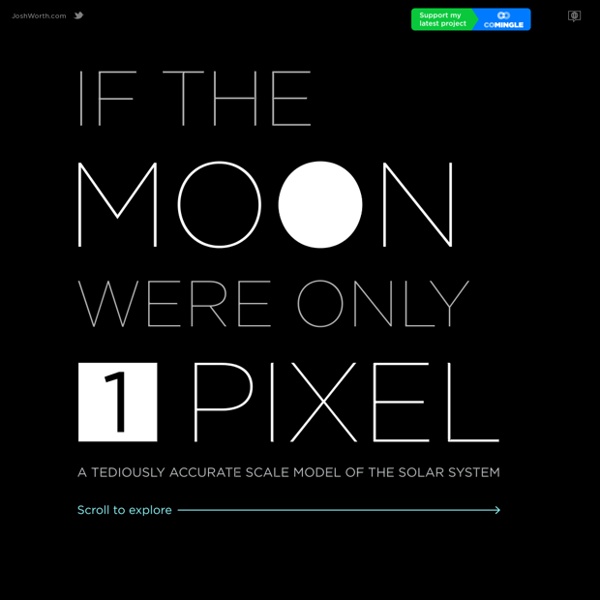Your Sky
by John Walker Welcome to Your Sky, the interactive planetarium of the Web. You can produce maps in the forms described below for any time and date, viewpoint, and observing location. If you enter the orbital elements of an asteroid or comet, Your Sky will compute its current position and plot it on the map. Each map is accompanied by an ephemeris for the Sun, Moon, planets, and any tracked asteroid or comet.
Mechanical Wavse Animated GIFs by Flipping Physics
Please understand there is no way for me to monetize animated GIFs.If you find them useful, please donate what you feel they are worth to you. From: Introduction to Waves
Day and Night World Map
+1 this page: Follow us on Google+: Like/share this page:
HighSchoolPhysics: Wolfram System Modeler Libraries
Canada (change country) HighSchoolPhysics Wolfram The HighSchoolPhysics library contains interactive physics labs for high-school students. After completing the labs, you will be able to understand the safety limits of a trampoline-like structure, how spring-damper systems are used to model real-life situations and how damping forces help in reducing the impact during collisions between railcars.
Magnifying the Universe
Embed this infographic on your site! <iframe width="500" height="323" scrolling="no" src=" frameborder="0" allowfullscreen></iframe><br />Copyright 2012. <a href=" the Universe</a> by <a href=" Sleuth</a>. The above is an interactive infographic. We have also developed a complimentary poster that you can view here: Sizes of the Universe poster. If you're technically inclined, here's a look at the references we used to construct these infographics: Facts About The Universe.
A Guide to Different Kinds of Parallel Universes « NOVA's Physics Blog: The Nature of Reality
These days it often seems that if a theory has loose ends, its dangling threads are surreptitiously tied together out of view within the hidden fabric of a parallel universe. While some researchers recoil from introducing unseen aspects to a theory, others find that the invisible knots create an irresistibly pretty package. Depending on one’s taste, there are so many types of parallel universes to choose from—alternative cosmos galore. If extra dimensions are not your thing, maybe bifurcating timelines would work. If an endless array of gigantic bubble universes seems intimidating, then perhaps a nursery of baby universes is more endearing. While there is not yet a GPS device or app to navigate through the cartography of scientifically sanctioned parallel possibilities, perhaps this guide to all things alternative will help.
HomeAdaptedILDs
Home Adapted ILDs Here you will find information on adaptations of Interactive Lecture Demonstrations (ILDs) to promote active learning of physics concepts for students working at home. These might be used as active learning components of an online introductory physics course. (1) I have adapted a subset of our Interactive Lecture Demonstrations (ILDs) to a form that can be easily used by students at home.
What Would Happen if the Earth Stopped Spinning?
Want to stay on top of all the space news? Follow @universetoday on Twitter This article was originally written in 2010, but we’ve now updated it and added this spiffy new video. As you probably know, the Earth is rotating on its axis. This gives us day and night.
How Fast Does the Earth Rotate?
Want to stay on top of all the space news? Follow @universetoday on Twitter This article originally appeared in 2009, but I’ve updated it and added this video.
Lunacy and the Full Moon
“It is the very error of the moon. She comes more near the earth than she was wont. And makes men mad.” —William Shakespeare, Othello ACROSS THE CENTURIES, many a person has uttered the phrase “There must be a full moon out there” in an attempt to explain weird happenings at night. Indeed, the Roman goddess of the moon bore a name that remains familiar to us today: Luna, prefix of the word “lunatic.”
Crash Test Launcher - Projectile Games - PhysicsGames
Spikey's Bounce AroundBounce your way through the vegetation as you guide Spikey in the magic gardens!Your quest is to release all butterflies by making the jars fall to the floor.HangerAn addictive projectile game! Use your rope to swing your way through 24 levels.
The Kessler Syndrome Explained
The Kessler Syndrome: 10 Interesting and Disturbing Facts Low Earth Orbit, an area of outer space around Earth that encloses all orbits below 2000 km, is the home of the International Space Station and of other thousands of satellites. It is also becoming a hazardous arena littered with mindless space junk and inoperable spacecraft orbiting at outrageous speeds. It’s a reality quite like Alfonso Cuarón’s film Gravity, and it’s called The Kessler Syndrome.
Universe has 2 trillion galaxies, astronomers say
There are a dizzying two trillion galaxies in the universe, up to 20 times more than previously thought, astronomers reported on Thursday. The surprising finding, based on 3D modeling of images collected over 20 years by the Hubble Space Telescope, was published in the Astronomical Journal. Scientists have puzzled over how many galaxies the cosmos harbors at least since US astronomer Edwin Hubble showed in 1924 that Andromeda, a neighboring galaxy, was not part of our own Milky Way. But even in the era of modern astronomy, getting an accurate tally has proven difficult. To begin with, there is only part of the cosmos where light given off by distant objects has had time to reach Earth. The rest is effectively beyond our reach.



